This article was originally published on Sistrix Blog on January 24, 2022.
- Methodology
- Government Sites & Health and Medical Authorities with High E-A-T
- Sites that Gain Visibility as their Inventory Grows
- Spotify’s Big Year
- Dictionaries, Reference, and Encyclopedia Sites: Reclassify User Intent
- Stock Photography Sites
- Ecommerce Sites
- Top 25 Winners (Absolute and Percentage)
- IndexWatch 2021 Winners in Other Countries
2021 was a volatile year for Google’s organic search results, with frequent algorithm updates – both confirmed and unconfirmed – ranging from several broad core updates, to Product Review updates, to the long-awaited Page Experience update.
Implementing an SEO strategy is one of many variables that can influence how a website fares during these algorithm updates. Organic search rankings may also be influenced by factors such as QDF (query deserves freshness), political and global events, significant shifts in consumer behavior (such as government-imposed lockdowns), seasonality, and more.
While many visibility changes can be tied to specific SEO efforts, others could be the influenced by these external factors, or could simply be the result of Google developing a better understanding of how to best meet search intent.
Below is a list of the 250 domains that saw the greatest increases in SEO visibility throughout 2021, both in terms of absolute gains and percentage increases.
Methodology
We have identified the 250 domains with the strongest growth – both in percentage and in absolute terms using the SISTRIX Visibility Index, which indicates a value for how visible a domain is in Google’s search results.
SISTRIX measures rankings of over 100 million domains for 100 million keywords on Google. The data below will focus specifically on Google’s U.S. index (Google.com).
By actively measuring the rankings across a representative keyword set, the SISTRIX data is free from external influences such as seasonality, the weather, vacation times and other external factors and trends.
The data shown below is collected from mobile search rankings only.
Government Sites & Health and Medical Authorities with High E-A-T
One of the most clear patterns from 2021 has been the increasing rise in visibility among government websites, as well as highly-trusted medical authorities who demonstrate significant E-A-T (expertise, authoritativeness and trustworthiness).
Some examples of domains falling into this category:
- Betterhealth.vic.gov.au
- Clevelandclinic.org
- Mayoclinic.org
- Hopkinsmedicine.org
- Bls.gov
- Cancer.gov
- Nhs.uk
- Healthcare.gov
- Wisconsin.gov
- Consumerfinance.gov
- Benefits.gov
- ssa.gov
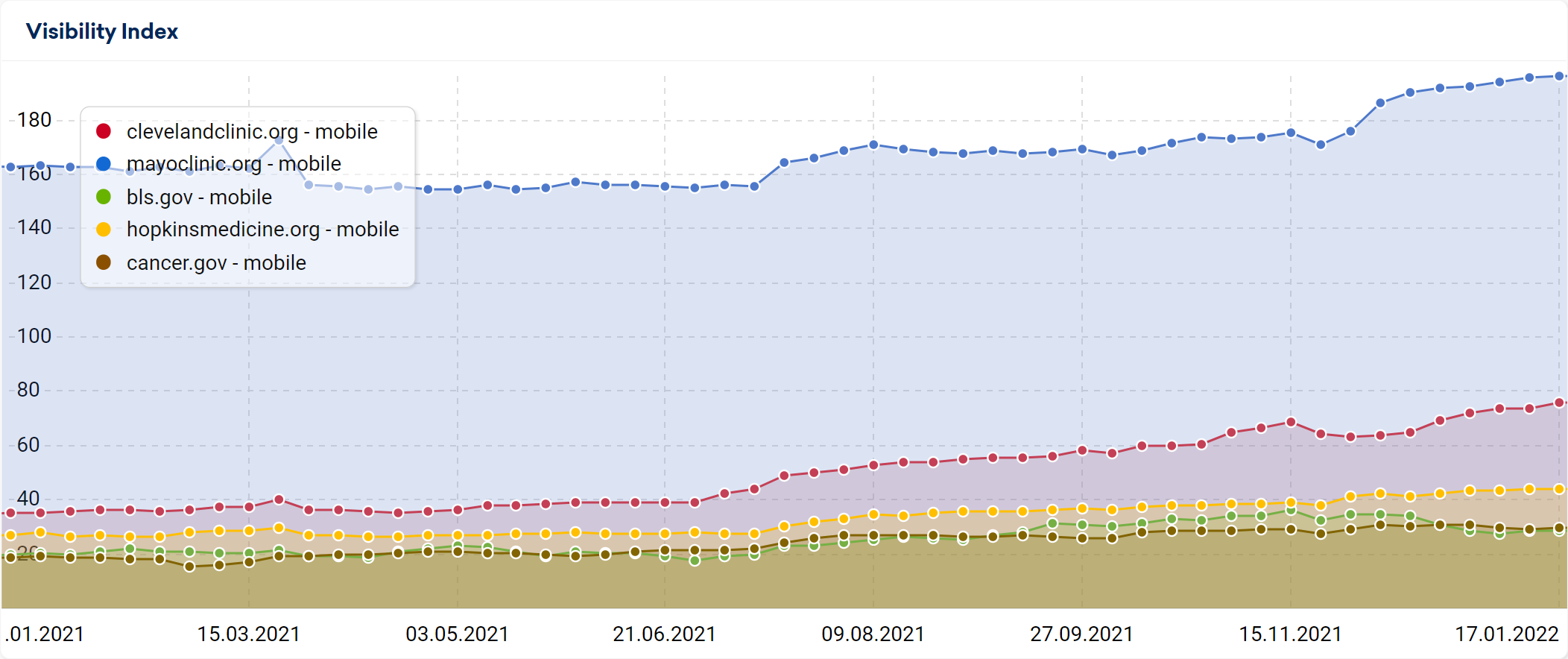
This trend is not unique to 2021; for the past several years (especially since the August 2018 Core Update), Google has confirmed they are increasing the visibility of highly authoritative sites for YMYL (your money, your life) queries.
Additionally, in “How Google Fights Disinformation,” Google states that “we have designed our systems to prefer authority over factors like recency or exact word matches while a crisis is developing.” This effect has been clear throughout the Coronavirus pandemic, and the trend seems to have continued throughout 2021.
Sites that Gain Visibility as their Inventory Grows
It’s important to remember that many of the biggest winners – especially sites in the “absolute winners” category – the visibility increases could largely be the result of a growing number of indexed URLs as new inventory and/or new content is added to the site. This is especially true for websites that tend to rank on page 1, such as social media sites, which often rank in top positions for an individual’s name.
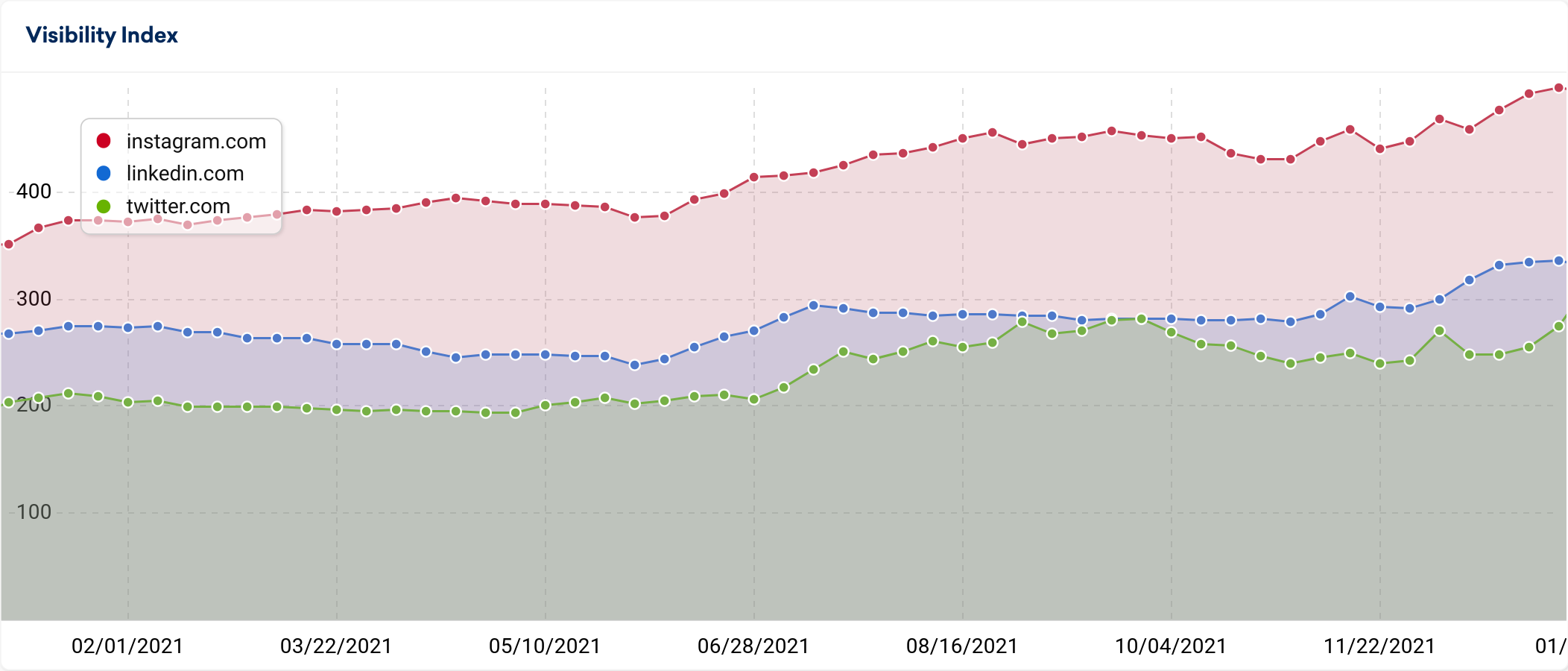
Below is an example of the growth of the number of indexed URLs on Instagram.com throughout the course of 2021, which grew from approximately 450 million indexed URLs to 588 million. While the increase in indexed URLs is likely not the only explanation leading to increased performance, a 30% increase in indexed URLs likely contributed to greater SEO visibility.
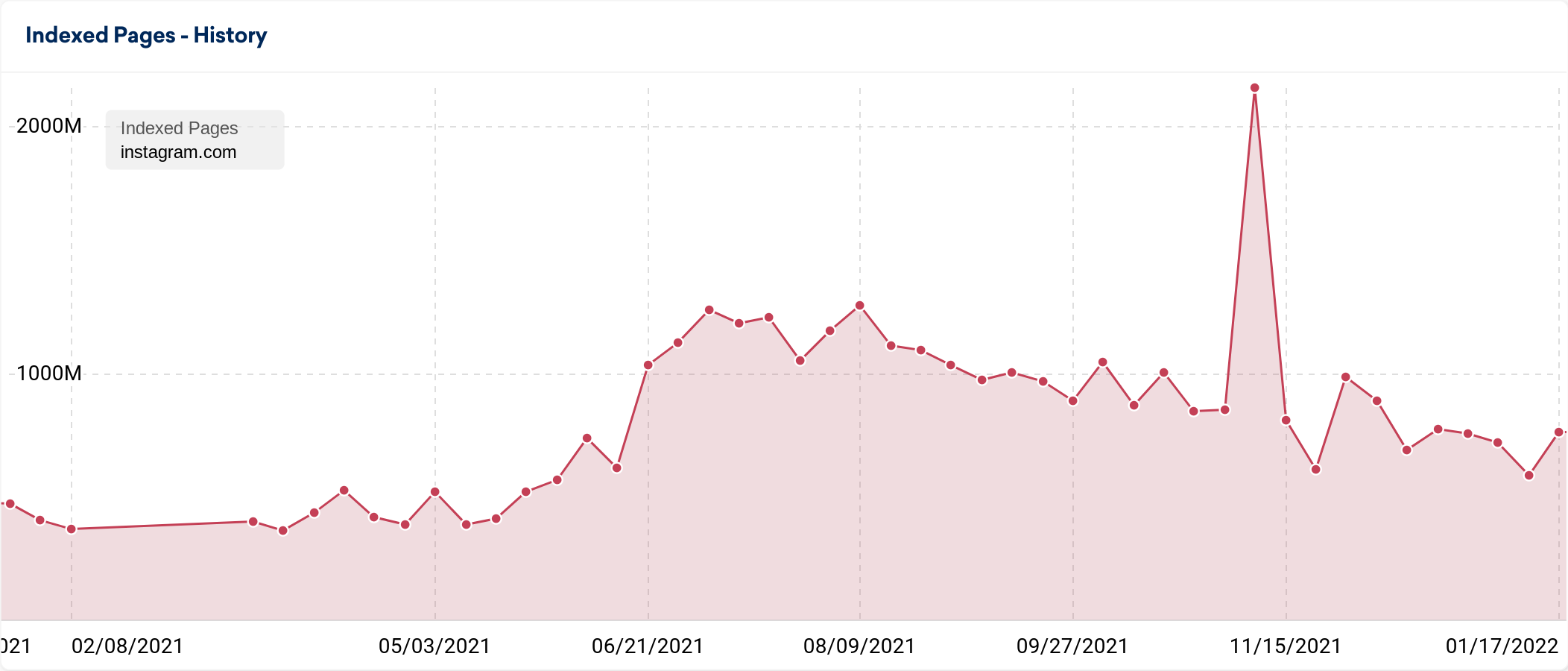
This same explanation could apply (at least in part) to the growth seen among many of the sites with the greatest total visibility increases, such as social media sites and ecommerce sites.
Spotify’s Big Year
Spotify was a big winner in 2021, earning top positions for many names of musical artists, including in cases where it previously did not rank on the first page. Spotify gained significant visibility between the April Product Review Update and the July Core Update.
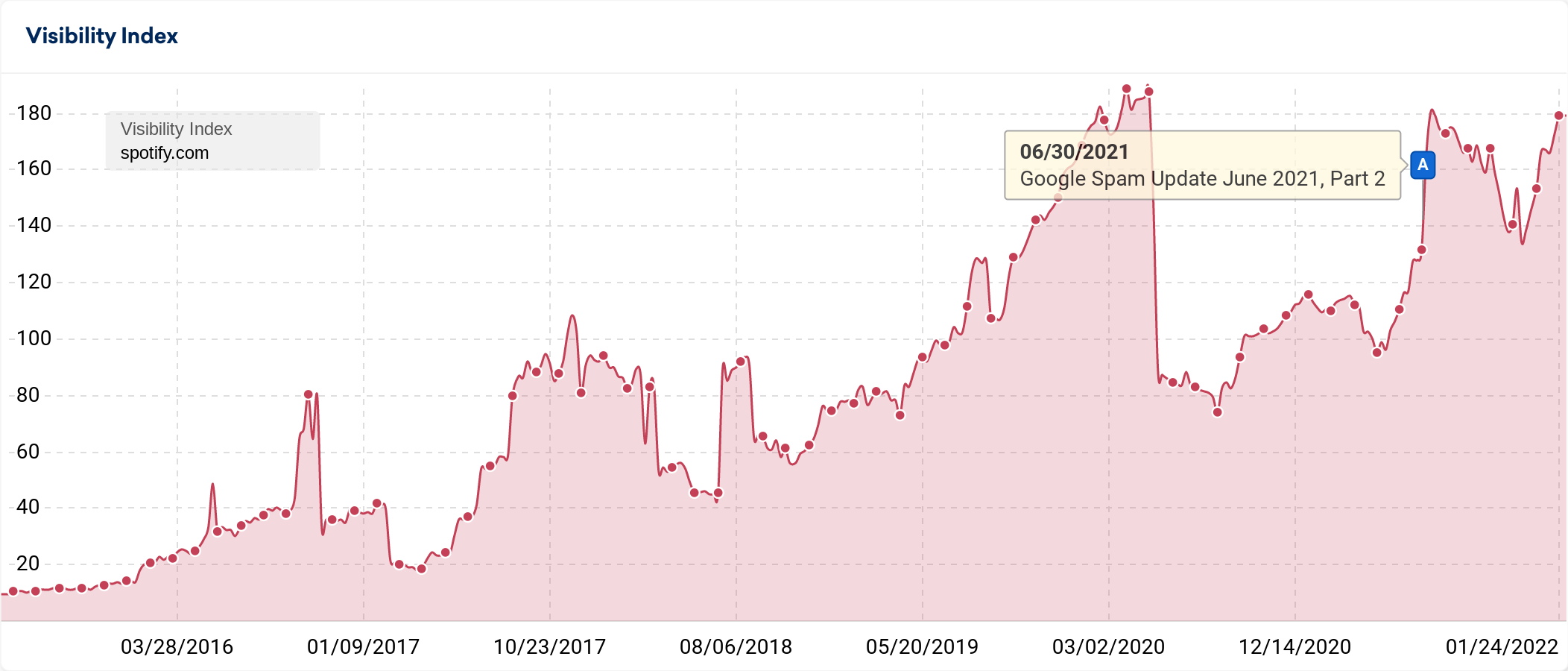
Here is an example of the types of ranking increases Spotify has seen in 2021.
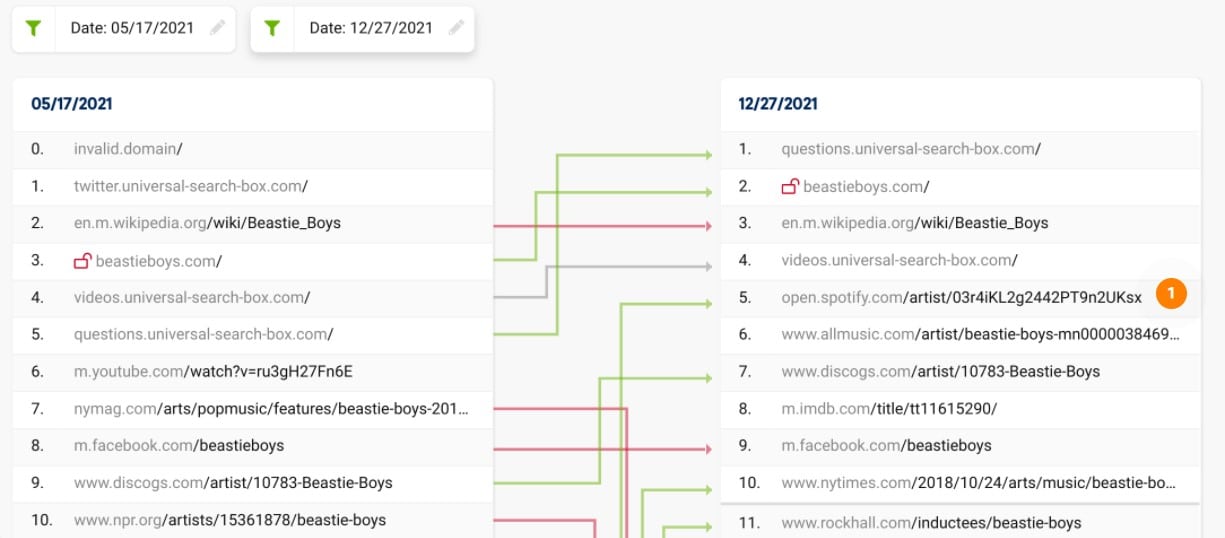
Spotify earned first-page rankings for many keywords in 2021, such as Beastie Boys 1 Snoop Dogg (MSV 328,000), Beyonce (541,000 MSV), and Kanye West (980,000 MSV).
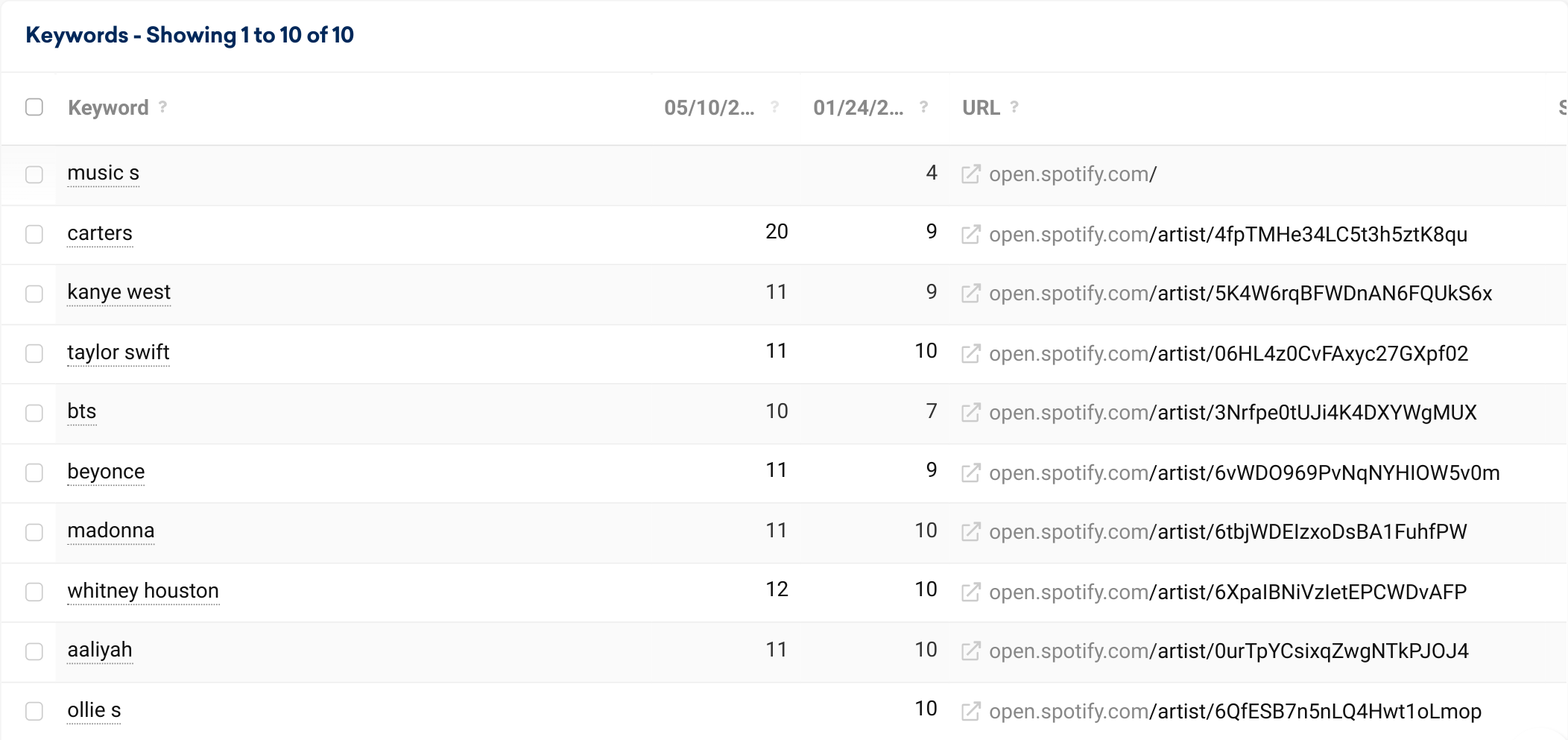
Dictionaries, Reference, and Encyclopedia Sites: Reclassifying User Intent
2021 was a good year for SEO visibility among some of the biggest dictionary websites, including merriam-webster.com, collinsdictionary.com, and more.
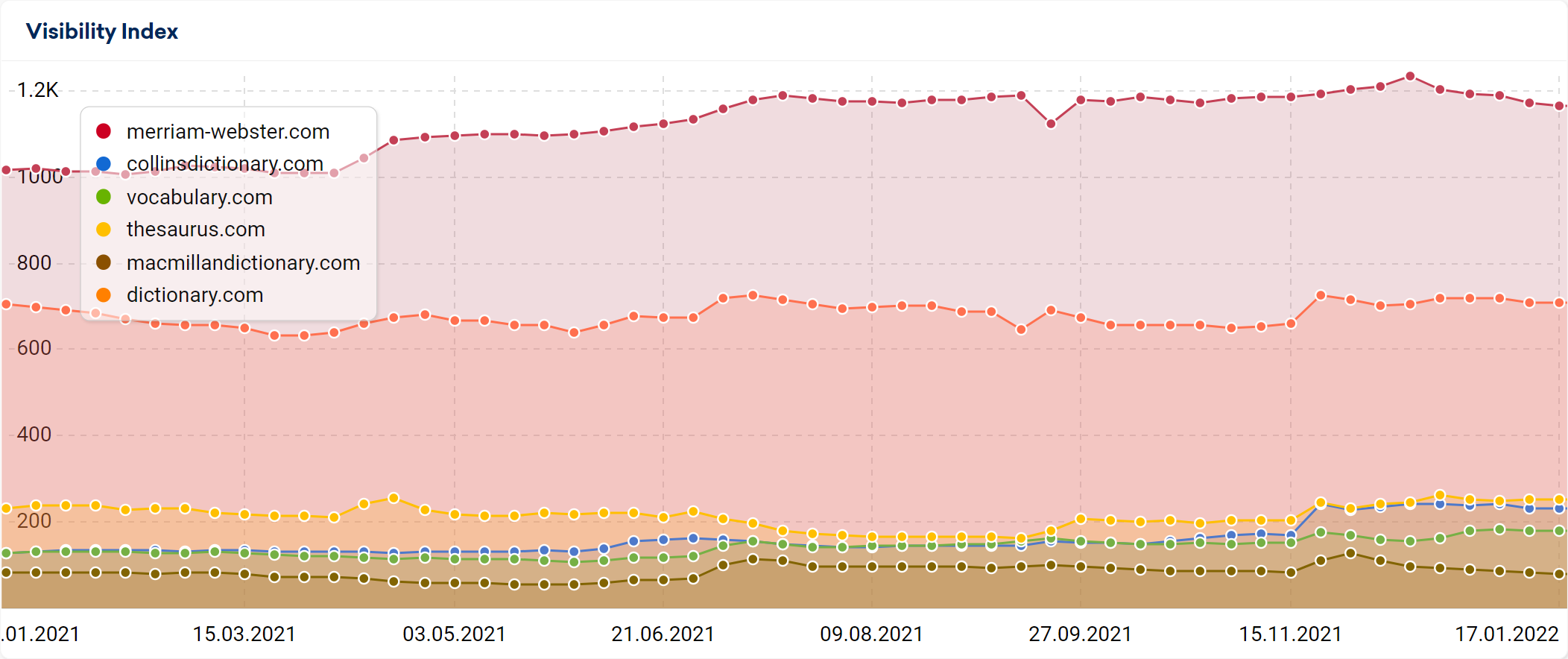
While this growth could also likely be tied to an increasing number of indexed URLs throughout the year, what made the visibility increases among dictionary sites unique is that many of the significant upticks in SEO rankings took place during Google core updates. This is especially true of the July 2021 Core Update and the November 2021 Core Update (letters E and G in the above chart).
One other possibility as to what may be taking place here is that Google is classifying more queries as deserving of dictionary results. In Google’s Search Quality Guidelines, Google provides a section dedicated to instructing quality raters on when a query should return a dictionary or encyclopedia result. In fact, as I indicated in an article analyzing the June 2021 Core Update, Google updated this section of the guidelines in 2020 to include the following:
When assigning Needs Met ratings for dictionary and encyclopedia results, careful attention must be paid to the user intent. Like all results, the helpfulness of dictionary and encyclopedia results depend on the query and user intent. Dictionary and encyclopedia results may be topically relevant for many searches, but often these results are not helpful for common words that most people in your rating locale already understand. Reserve high Needs Met ratings for dictionary and encyclopedia results when the user intent for the query is likely ‘what is it’ or ‘what does it mean’ and the result is helpful for users seeking that type of information.
It is possible that part of the core updates included reclassifying search intent for many queries so they now return dictionary definition results.
Here are two examples of what that looks like:
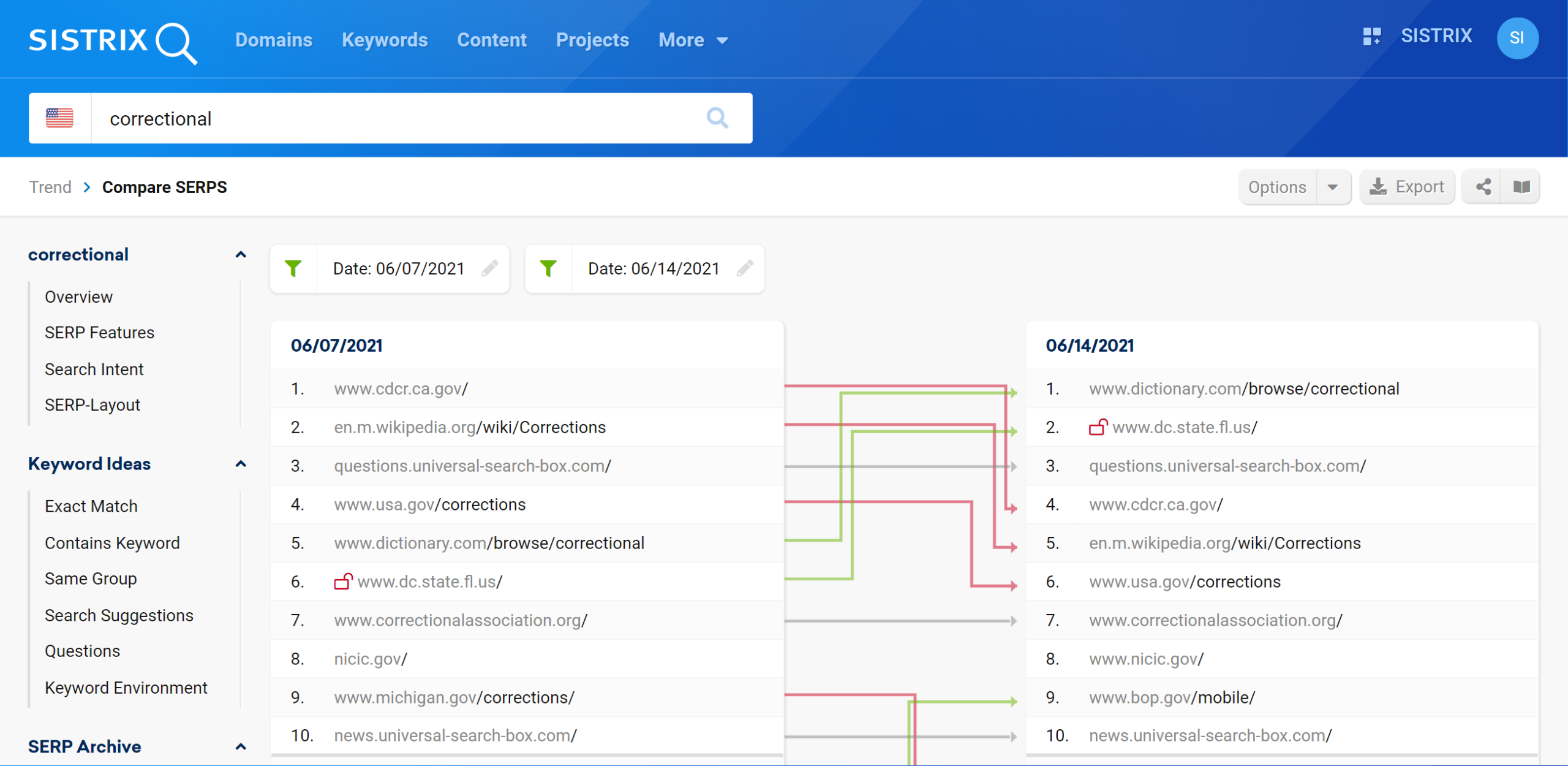
The word “correctional,” which previously returned a California Corrections Facility in the top result, was replaced by a dictionary.com definition result after the June Core Update.
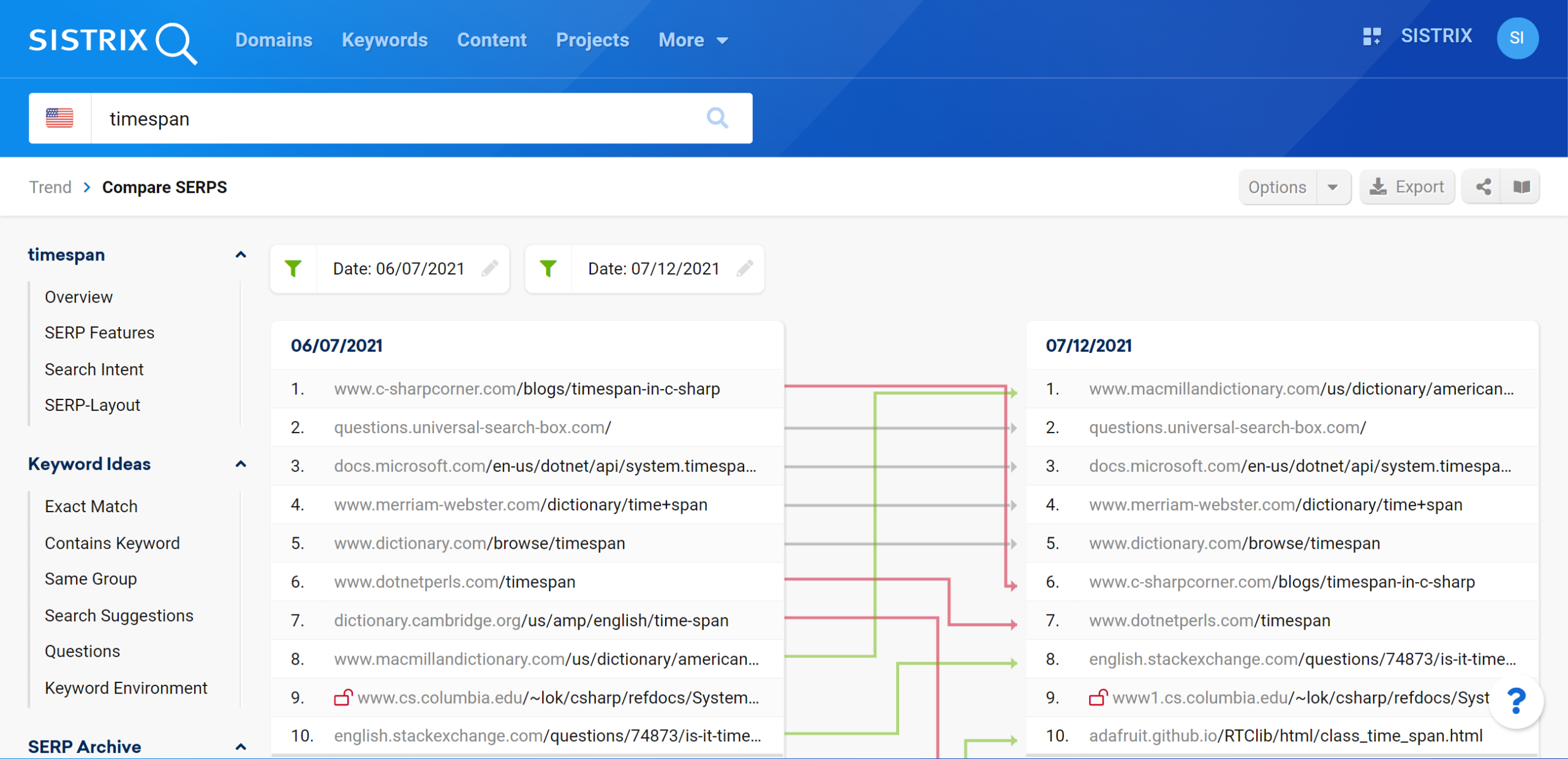
The keyword “timespan” originally returned a page about C# programming in position #1. After the July Core Update, it was replaced by a dictionary result.
When a core update results in these types of changes, it’s an indication that Google may have identified that a certain type of result is more relevant than the previous type. These intent shifts can be hard to respond to with an SEO strategy. As Google states in its core update guidelines:
“There’s nothing wrong with pages that may perform less well in a core update. They haven’t violated our webmaster guidelines nor been subjected to a manual or algorithmic action, as can happen to pages that do violate those guidelines. In fact, there’s nothing in a core update that targets specific pages or sites. Instead, the changes are about improving how our systems assess content overall. These changes may cause some pages that were previously under-rewarded to do better.”
Stock Photography Sites
Several big stock photography sites, such as Alamy, iStock Photo, and Shutterstock, all saw big increases throughout 2021. Similar to dictionary sites, some of the big upticks in visibility took place during core updates, which may indicate that Google classified many queries as deserving of image results.
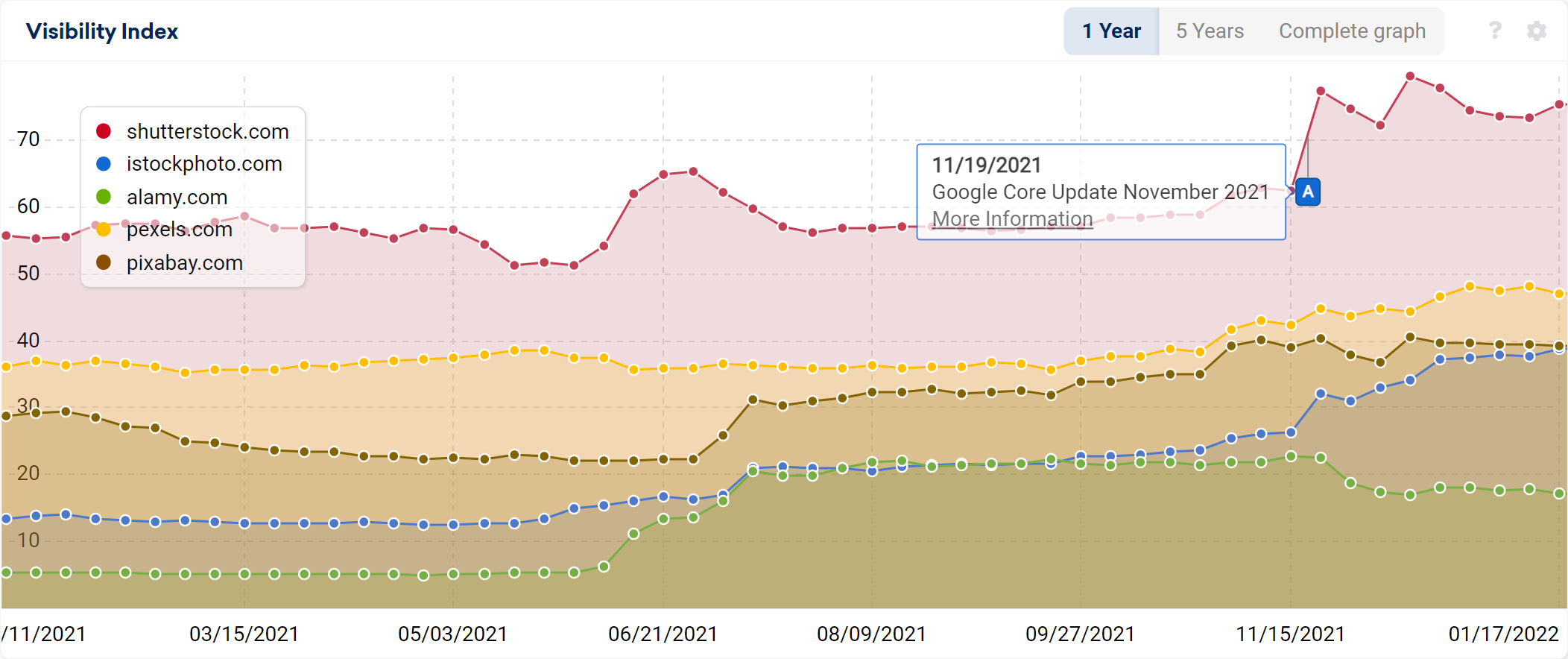
Zooming back to the past 5 years, this trend has been going on for a while, particularly starting around late 2019, and greatly exacerbated by the January 2020 Core Update.
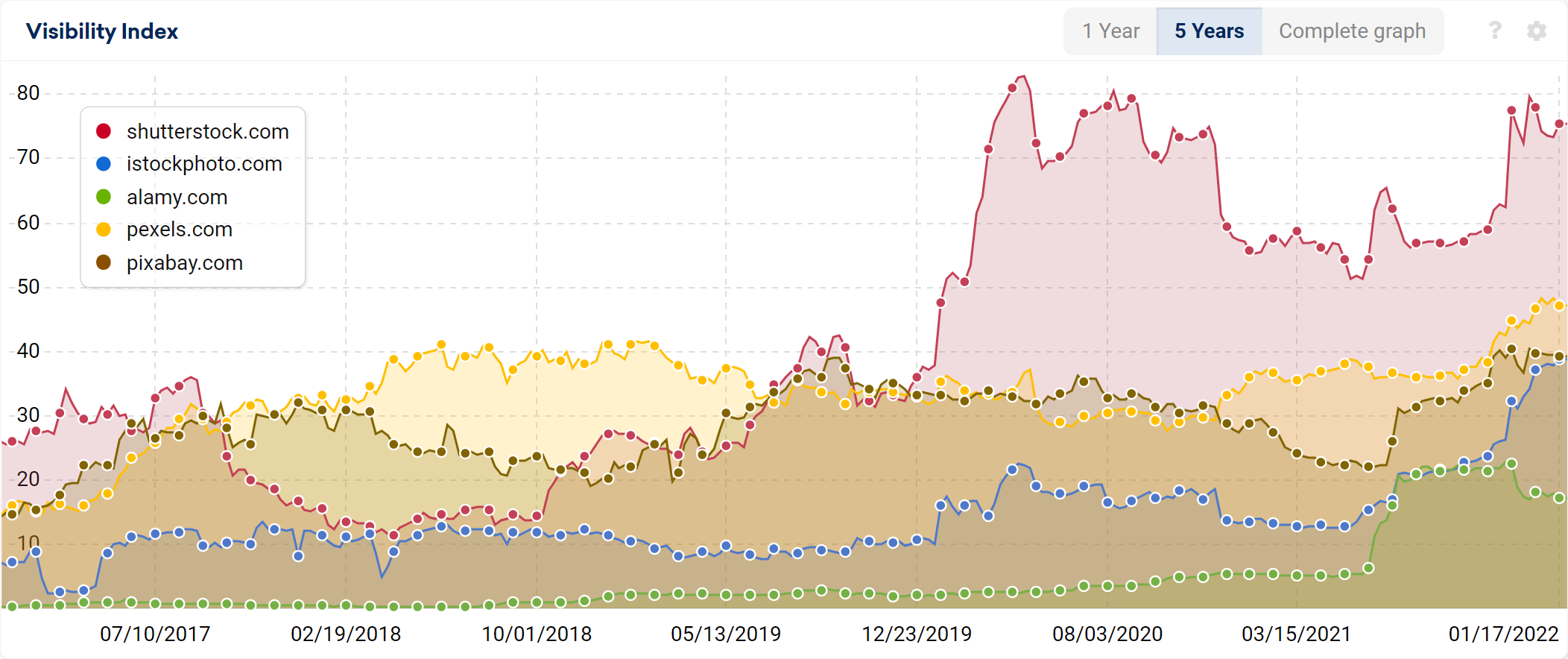
Ecommerce Sites
2021 was a big year for some of the big ecommerce sites, with huge surges in visibility taking place toward the end of the year. Nordstrom.com saw the greatest total visibility increase, while Walmart, Best Buy, and Target saw their biggest visibility surges ever in November and December.
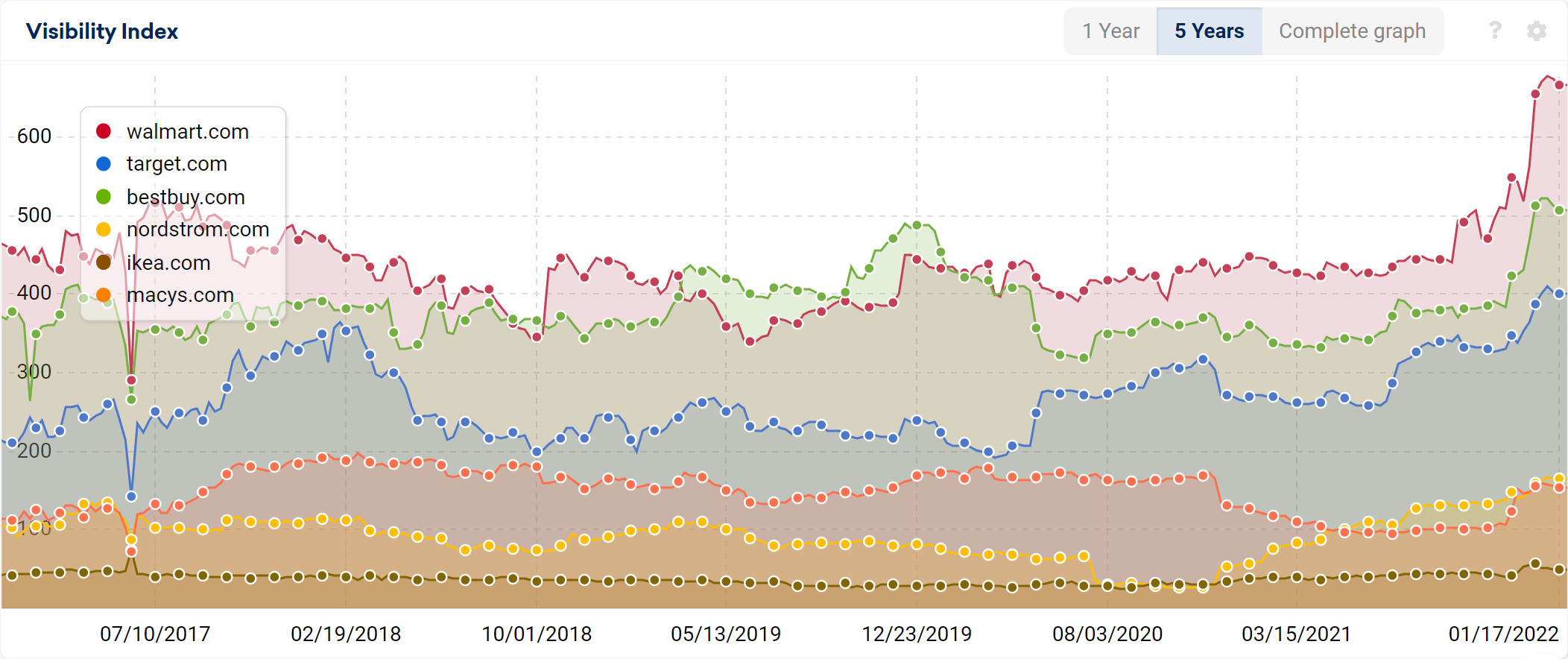
While these upticks are common during the holiday season, the increases seen in 2021 far outpaced those seen in previous years. While this may be due in part to the dramatic increases in online shopping seen throughout the Coronavirus pandemic, it also appears that Google began prioritizing these large ecommerce sites for many top rankings after the November 2021 Core Update.
Top 25 Winners (Absolute and Percentage)
Below, we have included two tables containing the top 25 domains (absolute and percent.) These have been filtered to remove adult content.
View the full, unfiltered list of top 250 domains that saw the highest absolute increases in Google visibility.
View the full, unfiltered list of top 250 domains that saw the highest percentage increases in Google visibility.
IndexWatch 2021 Winners in other countries
There are reports available for the following countries






